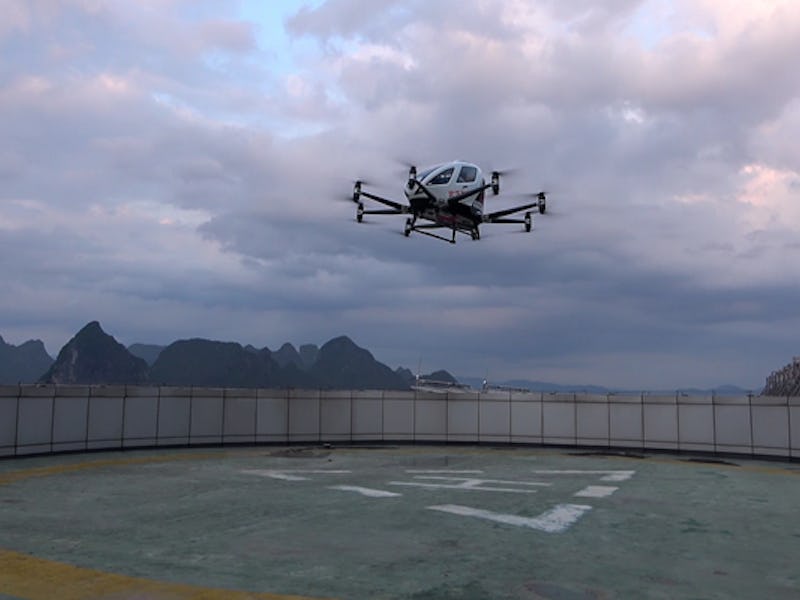Coronavirus: video shows air taxis bringing medical supplies where helicopters can’t in China
They're smaller than helicopters and fly themselves.

Coronavirus has sparked fear across the globe, infecting more than 83,000 people and killing more than 2,800 worldwide with shocking speed.
The fears are especially pronounced in Asia. The virus and its accompanying disease, COVID-19, has spread beyond its origins in Wuhan, China, and the country has seen a leveling off of infected numbers, but it’s still within the grips of a tough battle.
The Chinese Communist Party (CCP) has waged a battle with the medical crisis. The fight has pushed people into unexpected circumstances. Some of the most cutting-edge transportation technology around, electric vertical take off and landing (eVTOL) vehicles, also known as air taxis, are now being used to transport medical supplies.
The eVTOL seen in the video above is the EHang 216 AAV (autonomous aerial vehicle), developed by EHang, which is based in the southern Chinese city of Guangzhou in the province of Guangdong. A two-seater, the 216 model has 16 blades, and is capable of carrying a more than 570 pounds (260kg). That’s more than enough for medical supplies like test kits, swabs, or most medical equipment.
There are a number of reasons that an eVTOL would find uses in a crisis like coronavirus. They are smaller than helicopters—the 216 AAV is just under 6 feet tall (1.77 m) and 18.4 feet (5.61 m) wide. A standard R44 police helicopter, for comparison, is closer to 40 feet wide, requiring a specialized heliport. There's also the vehicle
The test, according to a press release from the company, took place in a city of approximately 1.4 million called Hezhou, based in a province immediately to the west of EHang’s home base, Guangxi. Hezhou is just a little over 559 miles (901 km) from Wuhan, and medical officials there have detected coronavirus.
The EHang 216 flight, which took place on February 26, saw the air taxi fly from Hezhou Square to the Hezhou People’s Hospital, a journey of 2.48 miles (4 km). At the hospital, the air taxi was able to land on top of the 25-story hospital.
"Personally, I’m proud to be one of the passengers to take the initial autonomous flights for medical emergency transport, and enjoyed the safe, fast and smooth journey. In urban emergency situation, this enables people or goods to be transported efficiently across the city in nearly straight-line routes.
"More importantly, as a passenger, I was free to enjoy my tea and urban scenery during the whole flight as everything was automatically piloted,” said Edward Xu, EHang’s Chief Strategy Officer (CSO), who rode in the eVTOL alongside the supplies, in a press statement.
The EHang 216 AAV flying over Hezhou.
Previously during the crisis, the company's air taxis were sent out to high-population areas to conduct "voluntary patrol and awareness campaigns, and remind people to not gather and put on masks," according to local news reports.
“Such successful flights have demonstrated EHang’s capabilities in delivering safe and high quality AAVs to meet mission-critical demands in real life. We will continue to implement more UAM [urban air mobility] applications.”
The CCP is waging two battles in China. One is the fight against coronavirus, and the other is a propaganda fight meant to encourage a feeling of unity within the country and that the coronavirus fight is one that the CCP will win.
To verify the video, Inverse contacted Chauncey Jung, a freelance writer on international affairs and technology, a China internet specialist who has previously worked for various Chinese internet companies in Beijing.
“There are no clear signs of state propaganda presence in the video, or in the above mentioned reports, neither do any of the information here came from state media outlets such as China Daily, Global Times, CCTV/etc.
"Neither does it put a huge emphasis on how good the government is doing on combating the virus,” Jung tells Inverse.
But it’s also worth noting, Jung says, “that this company promotional content cannot be done without the help from local authorities. In the case of the video here, it shows the company's collaboration with public health authorities in this city named Hezhou.”
That’s of crucial importance.
The air taxi taking off at Hezhou Square.
“For businesses in China, their interaction with local and central government are quite different from their counterparts in countries like the U.S. and Canada,” Jung tells Inverse. “Local governments often utilize resources from the private sectors to complete certain tasks, like the ones mentioned above.
"For companies this is a combination of promotion and government relations. From the companies' perspective these might be the opportunities for the general public to learn more about them and might be good for corporate image. And obviously, it will also be beneficial for the company to keep a positive relationship with local governments.”
"Obviously, it will also be beneficial for the company to keep a positive relationship with local governments."
Providing innovative help during a crisis would be a great promotional effort for any company, be they in China or America. And a search of Chinese social media site Weibo doesn’t show any particular effort to highlight EHang’s efforts, leading Jung to conclude that there are no signs of state propaganda, although the company does have ties with the local government.
EHang is preparing to go bigger. While the company was once focused solely on tourism, the current crisis has "opened up a new opportunity for EHang’s AAVs in immediate UAM applications such as medical emergency transport, which currently largely relies on ambulance cars or helicopters." Soon, the company hopes to be able to conduct transfers